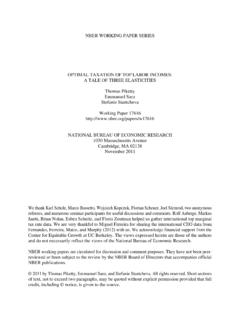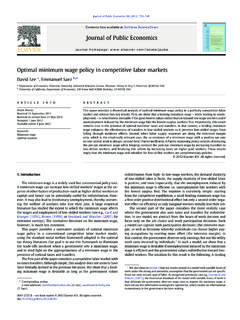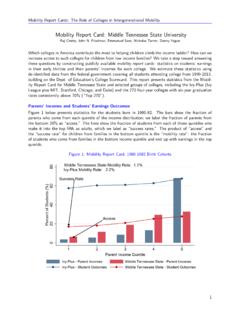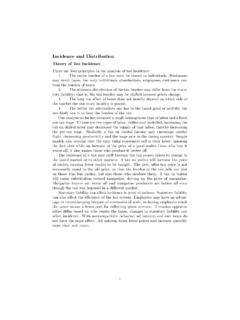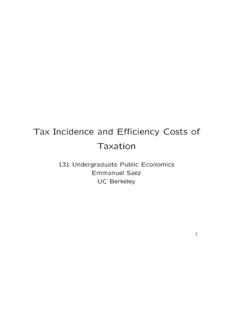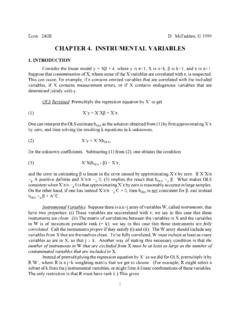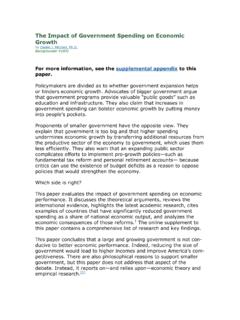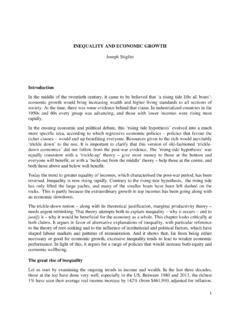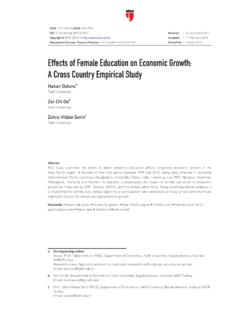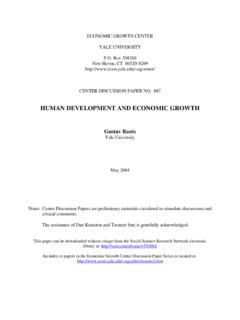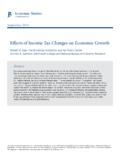Transcription of A Contribution to the Empirics of Economic Growth
1 A Contribution TO THE Empirics OF Economic Growth * N. GREGORY MANKIW DAVID ROMER DAVID N. WEIL This paper examines whether the Solow Growth model is consistent with the international variation in the standard of living. It shows that an augmented Solow model that includes accumulation of human as well as physical capital provides an excellent description of the cross-country data. The paper also examines the implications of the Solow model for convergence in standards of living, that is, for whether poor countries tend to grow faster than rich countries. The evidence indicates that, holding population Growth and capital accumulation constant, countries converge at about the rate the augmented Solow model predicts. INTRODUCTION This paper takes Robert Solow seriously. In his classic 1956 article Solow proposed that we begin the study of Economic Growth by assuming a standard neoclassical production function with decreasing returns to capital.
2 Taking the rates of saving and population Growth as exogenous, he showed that these two vari- ables determine the steady-state level of income per capita. Be- cause saving and population Growth rates vary across countries, different countries reach different steady states. Solow's model gives simple testable predictions about how these variables influ- ence the steady-state level of income . The higher the rate of saving, the richer the country. The higher the rate of population Growth , the poorer the country. This paper argues that the predictions of the Solow model are, to a first approximation, consistent with the evidence. Examining recently available data for a large set of countries, we find that saving and population Growth affect income in the directions that Solow predicted.
3 Moreover, more than half of the cross-country variation in income per capita can be explained by these two variables alone. Yet all is not right for the Solow model. Although the model correctly predicts the directions of the effects of saving and *We are grateful to Karen Dynan for research assistance, to Laurence Ball, Olivier Blanchard, Anne Case, Lawrence Katz, Robert King, Paul Romer, Xavier Sala-i-Martin, Amy Salsbury, Robert Solow, Lawrence Summers, Peter Temin, and the referees for helpful comments, and to the National Science Foundation for financial support. ? 1992 by the President and Fellows of Harvard College and the Massachusetts Institute of Technology. The Quarterly Journal of Economics, May 1992 408 QUARTERLY JOURNAL OF ECONOMICS population Growth , it does not correctly predict the magnitudes.
4 In the data the effects of saving and population Growth on income are too large. To understand the relation between saving, population Growth , and income , one must go beyond the textbook Solow model. We therefore augment the Solow model by including accumu- lation of human as well as physical capital. The exclusion of human capital from the textbook Solow model can potentially explain why the estimated influences of saving and population Growth appear too large, for two reasons. First, for any given rate of human- capital accumulation, higher saving or lower population Growth leads to a higher level of income and thus a higher level of human capital; hence, accumulation of physical capital and population Growth have greater impacts on income when accumulation of human capital is taken into account.
5 Second, human-capital accu- mulation may be correlated with saving rates and population Growth rates; this would imply that omitting human-capital accu- mulation biases the estimated coefficients on saving and population Growth . To test the augmented Solow model, we include a proxy for human-capital accumulation as an additional explanatory variable in our cross-country regressions. We find that accumulation of human capital is in fact correlated with saving and population Growth . Including human-capital accumulation lowers the esti- mated effects of saving and population Growth to roughly the values predicted by the augmented Solow model. Moreover, the augmented model accounts for about 80 percent of the cross- country variation in income . Given the inevitable imperfections in this sort of cross-country data, we consider the fit of this simple model to be remarkable.
6 It appears that the augmented Solow model provides an almost complete explanation of why some countries are rich and other countries are poor. After developing and testing the augmented Solow model, we examine an issue that has received much attention in recent years: the failure of countries to converge in per capita income . We argue that one should not expect convergence. Rather, the Solow model predicts that countries generally reach different steady states. We examine empirically the set of countries for which nonconvergence has been widely documented in past work. We find that once differences in saving and population Growth rates are accounted for, there is convergence at roughly the rate that the model predicts. THE Empirics OF Economic Growth 409 Finally, we discuss the predictions of the Solow model for international variation in rates of return and for capital move- ments.
7 The model predicts that poor countries should tend to have higher rates of return to physical and human capital. We discuss various evidence that one might use to evaluate this prediction. In contrast to many recent authors, we interpret the available evidence on rates of return as generally consistent with the Solow model. Overall, the findings reported in this paper cast doubt on the recent trend among economists to dismiss the Solow Growth model in favor of endogenous- Growth models that assume constant or increasing returns to scale in capital. One can explain much of the cross-country variation in income while maintaining the assump- tion of decreasing returns. This conclusion does not imply, how- ever, that the Solow model is a complete theory of Growth : one would like also to understand the determinants of saving, popula- tion Growth , and worldwide technological change, all of which the Solow model treats as exogenous.
8 Nor does it imply that endogenous- Growth models are not important, for they may provide the right explanation of worldwide technological change. Our conclusion does imply, however, that the Solow model gives the right answers to the questions it is designed to address. I. THE TEXTBOOK SOLOW MODEL We begin by briefly reviewing the Solow Growth model. We focus on the model's implications for cross-country data. A. The Model Solow's model takes the rates of saving, population Growth , and technological progress as exogenous. There are two inputs, capital and labor, which are paid their marginal products. We assume a Cobb-Douglas production function, so production at time t is given by (1) Y(t) = K(t)a(A(t)L(t))l- 0 < a. < 1. The notation is standard: Y is output, K capital, L labor, and A the level of technology.
9 L and A are assumed to grow exogenously at rates n and g: (2) L (t) = L ()ent (3) A (t) = A (r)ent. The number of effective units of labor, A (t)L (t), grows at rate n + g. 410 QUARTERLY JOURNAL OF ECONOMICS The model assumes that a constant fraction of output, s, is invested. Defining k as the stock of capital per effective unit of labor, k = KIAL, and y as the level of output per effective unit of labor, y = Y/AL, the evolution of k is governed by (4) k(t) = sy(t) - (n + g + 8)k (t) = sk(t)0 - (n + g + 8)k(t), where 8 is the rate of depreciation. Equation (4) implies that k converges to a steady-state value k* defined by sk *a = (n + g + 8)k *, or (5) k* = [s/(n + g + 5)]1I(1-a) The steady-state capital-labor ratio is related positively to the rate of saving and negatively to the rate of population Growth .
10 The central predictions of the Solow model concern the impact of saving and population Growth on real income . Substituting (5) into the production function and taking logs, we find that steady- state income per capita is (6)tl [Ot]ln()gt (6) In = In A (0) + gt + 1 In(s) - 1 ln(n + g + 8). Because the model assumes that factors are paid their marginal products, it predicts not only the signs but also the magnitudes of the coefficients on saving and population Growth . Specifically, because capital's share in income (a) is roughly one third, the model implies an elasticity of income per capita with respect to the saving rate of approximately and an elasticity with respect to n + g + 8 of approximately B. Specification The natural question to consider is whether the data support the Solow model's predictions concerning the determinants of standards of living.
